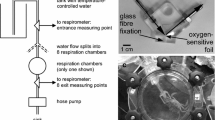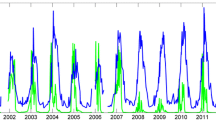Abstract
Little is known about the metabolism of deep-living, benthic invertebrates, despite its importance in estimating energy flow through individuals and populations. To evaluate the effects of depth and broad taxonomic group/locomotory mode, we measured the respiration rates of 25 species of benthic decapod crustaceans and 18 species of echinoderms from the littoral zone to the deep slope of Hawaii. Specimens were collected by hand, trap, or submersible and maintained in the laboratory at temperatures close to ambient temperatures recorded at the time of collection. After acclimatization to laboratory conditions, oxygen consumption was measured for each individual in closed chambers. Overall, crustaceans had higher metabolic rates than echinoderms, and within the crustaceans, caridean shrimps had higher rates than crabs and lobsters. These differences are probably related to locomotory mode and general levels of activity. At in situ environmental temperatures, metabolic rates of deeper-living invertebrates are much lower than those of shallower living species, but this decline is explained by changes in temperature. When the data were compared with similar data sets collected off California and in the Mediterranean, Hawaiian crabs, lobsters, and echinoderms had lower metabolic rates than similar species in the other regions after adjustments for temperature were made. Some of these differences could be methodological. Regional food web models should use broad taxonomic groupings and region-specific data when possible.



Similar content being viewed by others
References
Anderson MJ, Gorley RN, Clarke KR (2008) PERMANOVA+ for PRIMER: guide to software and statistical methods. PRIMER-E Ltd, Plymouth
Belman BW, Gordon MS (1979) Comparative studies on the metabolism of shallow-water and deep-sea marine fishes. 5. Effects of temperature and hydrostatic pressure on oxygen consumption in the mesopelagic Melanostigma pammelas. Mar Biol 50:275–281
Brey T (2010) An empirical model for estimating aquatic invertebrate respiration. Methods Ecol Evol 1:92–101. doi:10.1111/j.2041-210X.2009.00008.x
Brown JH, Gillooly JF, Allen AP, Savage VM, West GB (2004) Toward a metabolic theory of ecology. Ecology 85:1771–1789
Chave EH, Malahoff A (1994) In deeper waters: photographic studies of Hawaiian deep-sea habitats and life-forms. University of Hawaii Press, Honolulu
Childress JJ (1975) The respiratory rates of midwater crustaceans as a function of depth of occurrence and relation to the oxygen minimum layer off southern California. Comp Biochem Physiol 50A:787–799
Childress JJ (1977) Effects of pressure, temperature and oxygen on the oxygen-consumption rate of the midwater copepod Gaussia princeps. Mar Biol 39:19–24
Childress JJ (1985) Capture and live recovery of deep-sea crustaceans. Natl Geogr Soc Res Rep 21:67–69
Childress JJ (1995) Are there physiological and biochemical adaptations of metabolism in deep-sea animals? Trends Ecol Evol 10:30–36
Childress JJ, Thuesen EV (1993) Effects of hydrostatic pressure on metabolic rates of six species of deep-sea gelatinous zooplankton. Limnol Oceanogr 38:665–670
Childress JJ, Cowles DL, Favuzzi JA, Mickel TJ (1990) Metabolic rates of benthic deep-sea decapod crustaceans decline with increasing depth primarily due to the decline in temperature. Deep Sea Res 37:929–949
Childress JJ, Seibel BA, Thuesen EV (2008) N-specific metabolic data are not relevant to the ‘visual interactions’ hypothesis concerning the depth-related declines in metabolic rates: comment on Ikeda et al. (2006). Mar Ecol Prog Ser 373:187–191
Clarke TA (1972) Collections and submarine observations of deep benthic fishes and decapod Crustacea in Hawaii. Pac Sci 26:310–317
Collins MA, Priede IG, Bagley PM (1999) In situ comparison of activity in two deep-sea scavenging fishes occupying different depth zones. Proc R Soc Lond B 266:2011–2016
Company JB, Sarda F (1998) Metabolic rates and energy content of deep-sea benthic decapod crustaceans in the western Mediterranean Sea. Deep-Sea Res I 45:1861–1880
Cowles DL, Childress JJ, Wells ME (1991) Metabolic rates of midwater crustaceans as a function of depth of occurrence off the Hawaiian Islands: food availability as a selective factor? Mar Biol 110:75–83
Dalhoff EP (2004) Biochemical indicators of stress and metabolism: applications for marine ecological studies. Annu Rev Physiol 66:183–207
Donnelly J, Torres JJ (1988) Oxygen consumption of midwater fishes and crustaceans from the eastern Gulf of Mexico. Mar Biol 97:483–494
Drazen JC, Seibel BA (2007) Depth-related trends in metabolism of benthic and benthopelagic deep-sea fishes. Limnol Oceanogr 52:2306–2316
Drazen JC, Yeh J (2012) Respiration of four species of deep-sea demersal fishes measured in situ in the eastern North Pacific. Deep-sea Res I 60:1–6
Drazen JC, Reisenbichler KR, Robison BH (2007) A comparison of assimilation efficiencies between four species of shallow and deep living fishes. Mar Biol 151:1551–1558
Drazen JC, Yeh J, Friedman JR, Condon N (2011) Metabolism and enzyme activities of hagfish from shallow and deep water of the Pacific Ocean. Comp Biochem Physiol A 159:182–187
Erdman RB, Blake NJ, Torres JJ (1991) Oxygen consumption of the deep-sea crabs Chaceon fenneri and C. quinquedens (Brachyura: Geryonidae). Comp Biochem Physiol A 99A:383–385
Gooding RM (1984) Trapping surveys for the deepwater caridean shrimps, Heterocarpus laevigatus and H. ensifer, in the northwestern Hawaiian Islands. Mar Fish Rev 46:18–26
Gooding RM, Polovina JJ, Dailey MD (1988) Observations of deepwater shrimp, Heterocarpus ensifer, from a submersible off the Island of Hawaii. Mar Fish Rev 50:32–38
Hughes SJM, Ruhl HA, Hawkins LE, Hauton C, Boorman B, Billett DSM (2011) Deep-sea echinoderm oxygen consumption rates and an interclass comparison of metabolic rates in Asteroidea, Crinoidea, Echinoidea, Holothuroidea and Ophiuroidea. J Exp Biol 214:2512–2521. doi:10.1242/jeb.055954
Ikeda T, Sano F, Yamaguchi A, Matsuishi T (2006) Metabolism of mesopelagic and bathypelagic copepods in the western North Pacific Ocean. Mar Ecol Prog Ser 322:199–211
Karl DM, Lukas R (1996) The Hawaii Ocean Time-series (HOT) program: background, rationale and field implementation. Deep-Sea Res II 43:129–156
Longhurst AR (1998) Ecological geography of the sea. Academic Press, New York
Mickel TJ, Childress JJ (1982) Effects of pressure and pressure acclimation on activity and oxygen consumption in the bathypelagic mysid Gnathophausia ingens. Deep Sea Res 29:1293–1301
Moffitt RB, Parrish FA (1992) An assessment of the exploitable biomass of Heterocarpus laevigatus in the main Hawaiian Islands. Part 2: observations from a submersible. Fish Bull 90:476–482
Raymond EH, Widder EA (2007) Behavioral responses of two deep-sea fish species to red, far-red, and white light. Mar Ecol Prog Ser 350:291–298
Ruhl H (2008) Community change in the variable resource habitat of the abyssal northeast Pacific. Ecology 89:991–1000
Seibel BA, Drazen JC (2007) The rate of metabolism in marine animals: environmental constraints, ecological demands and energetic opportunities. Philos Trans R Soc Lond B 362:2061–2078
Seibel BA, Thuesen EV, Childress JJ, Gorodezky LA (1997) Decline in pelagic cephalopod metabolism with habitat depth reflects differences in locomotory efficiency. Bio Bull 192:262–278
Smith KL Jr (1983) Metabolism of two dominant epibenthic echinoderms measured at bathyal depths in the Santa Catalina Basin. Mar Biol 72:249–256
Smith KL Jr, Kaufmann RS, Wakefield WW (1993) Mobile megafaunal activity monitored with a time-lapse camera in the abyssal North Pacific. Deep Sea Res 40:2307–2324
Steffensen JF (1989) Some errors in respirometry of aquatic breathers: how to avoid and correct them. Fish Physiol Bio-Chem 6:49–59
Vetter EW, Smith CR, De Leo FC (2010) Hawaiian hotspots: enhanced megafaunal abundance and diversity in submarine canyons on the oceanic islands of Hawaii. Mar Ecol:1–17. doi:10.1111/j.1439-0485.2009.00351.x
Warrant EJ, Locket NA (2004) Vision in the deep-sea. Biol Rev 79:671–712
Webster SK (1975) Oxygen consumption in echinoderms from several geographical locations, with particular reference to the Echinoidea. Bio Bull 148:157–164
Widdicombe S, Spicer JI (2008) Predicting the impact of ocean acidification on benthic biodiversity: what can animal physiology tell us? J Exp Mar Biol Ecol 366:187–197. doi:10.1016/j.jembe.2008.07.024
Acknowledgments
Thanks to Erica Aus, Nicole Condon, Chris Demarke, Anela Choy, Jason Friedman, William Misa, and Cordelia Moore for help at sea and in the laboratory. Ethan Capone and Cassandra Drazen assisted with collection of shallow-water species. Chris Kelley provided depth information from the NOAA, Hawaii Undersea Research Laboratory (HURL) database. Chris Mah, Robert Moffitt, Les Watling, and Kareen Schnabel helped with specimen identification. We thank the submersible crew of HURL for their outstanding attitude and ability to achieve our science objectives. Thanks also to the captain and crew of the RV Ka’imikai-o-Kanaloa. This research was supported by grants from NSF-OCE (#0727135) and NOAA-HURL to J. C. Drazen. Support to K. E. Korsmeyer was provided by the Hawaii Pacific University Trustee’s Scholarly Endeavors Program.
Author information
Authors and Affiliations
Corresponding author
Additional information
Communicated by J. P. Grassle.
Rights and permissions
About this article
Cite this article
Wilson, S., Yeh, J., Korsmeyer, K.E. et al. Metabolism of shallow and deep-sea benthic crustaceans and echinoderms in Hawaii. Mar Biol 160, 2363–2373 (2013). https://doi.org/10.1007/s00227-013-2230-8
Received:
Accepted:
Published:
Issue Date:
DOI: https://doi.org/10.1007/s00227-013-2230-8




